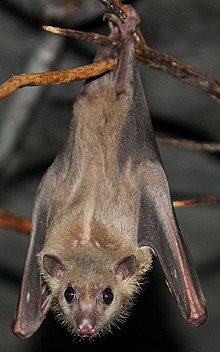| Egyptian fruit bat | |
|---|---|

| |
| Scientific classification | |
| Domain: | Eukaryota |
| Kingdom: | Animalia |
| Phylum: | Chordata |
| Class: | Mammalia |
| Order: | Chiroptera |
| Family: | Pteropodidae |
| Genus: | Rousettus |
| Species: | R. aegyptiacus
|
| Binomial name | |
| Rousettus aegyptiacus (Geoffroy, 1810)
| |

| |
| Egyptian fruit bat range | |
| Synonyms[6] | |
|
List
| |
The Egyptian fruit bat or Egyptian rousette (Rousettus aegyptiacus) is a species of megabat that occurs in Africa, the Middle East, the Mediterranean and the Indian subcontinent. It is one of three Rousettus species with an African-Malagasy range, though the only species of its genus found on continental Africa. The common ancestor of the three species colonized the region in the late Pliocene or early Pleistocene. The species is traditionally divided into six subspecies. It is considered a medium-sized megabat, with adults weighing 80–170 g (2.8–6.0 oz) and possessing wingspans of approximately 60 cm (24 in). Individuals are dark brown or grayish brown, with their undersides paler than their backs.
The Egyptian fruit bat is a highly social species, usually living in colonies with thousands of other bats. It, along with other members of the genus Rousettus, are some of the only fruit bats to use echolocation, though a more primitive version than used by bats in other families. It has also developed a socially-complex vocalization system to communicate with conspecifics. The Egyptian fruit bat is a frugivore that consumes a variety of fruits depending on the season and local availability. Because of its consumption of commercially-grown fruits, the Egyptian fruit bat is considered a pest by farmers. It also acts as a pollinator and seed disperser for many species of trees and other plants.
- ^ Korine, C. (2016). "Rousettus aegyptiacus". IUCN Red List of Threatened Species. 2016: e.T29730A22043105. doi:10.2305/IUCN.UK.2016-2.RLTS.T29730A22043105.en. Retrieved 19 November 2021.
- ^ a b c d e f g h i j k Happold, M. (2013). Kingdon, J.; Happold, D.; Butynski, T.; Hoffmann, M.; Happold, M.; Kalina, J. (eds.). Mammals of Africa. Vol. 4. A&C Black. pp. 373–375. ISBN 9781408189962.
- ^ a b Cite error: The named reference
Kwiecinski et al., 1999was invoked but never defined (see the help page). - ^ Gray, J. E. (1870). Catalogue of monkeys, lemurs, and fruit-eating bats in the collection of the British Museum. Order of the Trustees. p. 107.
- ^ Srinivasulu, C.; Srinivasulu, B. (2012). South Asian mammals : their diversity, distribution, and status. New York, NY: Springer. p. 242. ISBN 978-1-4614-3449-8. OCLC 794056010.
- ^ Cite error: The named reference
Simmons, 2005was invoked but never defined (see the help page).
